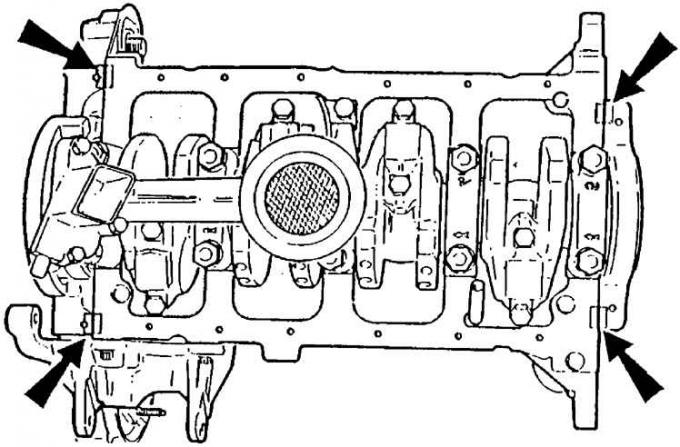Identification symbols and labels for the correct position of the piston and connecting rod

1 - designation of the piston diameter, 2 - designation of the direction of installation in the cylinder (the arrow must be directed towards the drive of the gas distribution system), 3 - designation of the direction of installation of the connecting rod relative to the piston (letter "F" must point in the same direction as the arrow on the bottom of the piston), 4 - designation of the cylinder number, 5 - designation of the length of the connecting rod, 6 - designation of the mass of the connecting rod
Places for applying sealing paste on the surface of the engine block


1. Install the crankshaft thrust races into the seats in the middle main bearing, guiding the oil grooves of the races out of the main bearing.
2. Insert the main bearing shells.
3. Lubricate the main and connecting rod journals of the shaft and the main bearing shells with oil.
4. Install the crankshaft on the main bearing shells in the engine block.
5. Install main bearing caps (arrows on the covers directed towards the drive of the gas distribution system) along with inserts.
6. Lubricate the threads of the new main bearing cap bolts with oil.
7. Tighten the main bearing cap bolts to the correct torque.
8. If the piston rings were removed, then install them on the pistons with the inscription "TOP", directed towards the bottom of the piston.
9. Arrange the locks of the rings at an angle of 120°.
10. Lubricate the smooth surface of the cylinders, the side surfaces of the pistons and the piston rings with oil.
11. Install the half shells in the connecting rod bases.
12. Install the piston-rod units in the cylinders, paying attention to the installation marks (see fig. Identification symbols and labels for the correct position of the piston and connecting rod):
- connecting rod and cap are marked with the number of the cylinder in which they are installed (cylinder No. 1 from the drive side of the gas distribution system);
- arrow on the bottom of the piston and the letter "F" on the side surface of the neck of the connecting rod should be directed towards the drive of the gas distribution system;
- connecting rods are divided into four selection groups, differing in the distance between the axes of the holes of the head and base; this allows you to limit to a minimum the difference in protrusion of the piston above the upper plane of the cylinder block (and thus the difference in compression ratio in the individual cylinders); the selection group of the distance between the axes of the connecting rods is indicated by letters "A", "IN", "WITH" And "D", embossed on the connecting rod caps (letter "A" belongs to the shortest connecting rods);
- connecting rods are divided into two selection groups depending on their mass: "light" (easy) And "heavy" (heavy); all connecting rods in an engine must belong to the same mass group.
13. Insert half shells into connecting rod caps.
14. Lubricate the connecting rod bearings and shaft journals with oil.
15. Install the connecting rod caps, paying attention to their designation (see fig. Identification symbols and labels for the correct position of the piston and connecting rod).
16. Install new connecting rod cap bolts and coat threads with oil.
17. Tighten the connecting rod cap bolts to the correct torque.
18. Lubricate the O-ring of the oil supply pipe to the oil pump with oil.
19. Install the oil supply line and check that the gasket is in the correct position.
20. Install the rear crankshaft cover with a new gasket that reaches the bottom of the engine block.
21. Using special tool 21.148 and the mounting bolt, install the crankshaft pulley, the front plate of the cylinder block with a new gasket.
22. Lubricate the front crankshaft journal and the pulley O-ring with oil.
23. Install the pulley on the crankshaft, making sure that the keyway with the key in the neck is exactly opposite the groove in the pulley.
24. Lubricate the intermediate shaft and bearing bushes in the cylinder block and the front support plate with oil.
25. Install the intermediate shaft together with the support plate into the cylinder block.
26. Lubricate the indicated places (see fig. Places for applying sealing paste on the surface of the engine block): Apply a thin layer of sealing paste and install the oil pan with a new gasket.
27. First insert the four mounting bolts at the corners of the oil pan, tighten them by hand, then insert and tighten the rest of the oil pan mounting bolts by hand.
28. Tighten the bolts - with the exception of the bolts in the corners of the pallet - to the appropriate torque.
29. Tighten the bolts at the corners of the oil pan to the correct torque.
30. Install the water pump with a new gasket.
31. Pour about 10 cm3 of oil into the oil pump.
32. Install the oil pump.
33. Screw on the oil filter.
34. Install the engine cylinder head (see subsection 3.2.1.4.4).
35. Install generator.
36. Install fuel pump (see subsection 3.2.1.3.3)
37. Install the pulley on the crankshaft.
38. Install the flywheel on the crankshaft.
39. Install the clutch on the flywheel.
40. Install starter.
41. Install the exhaust manifold.
Visitor comments